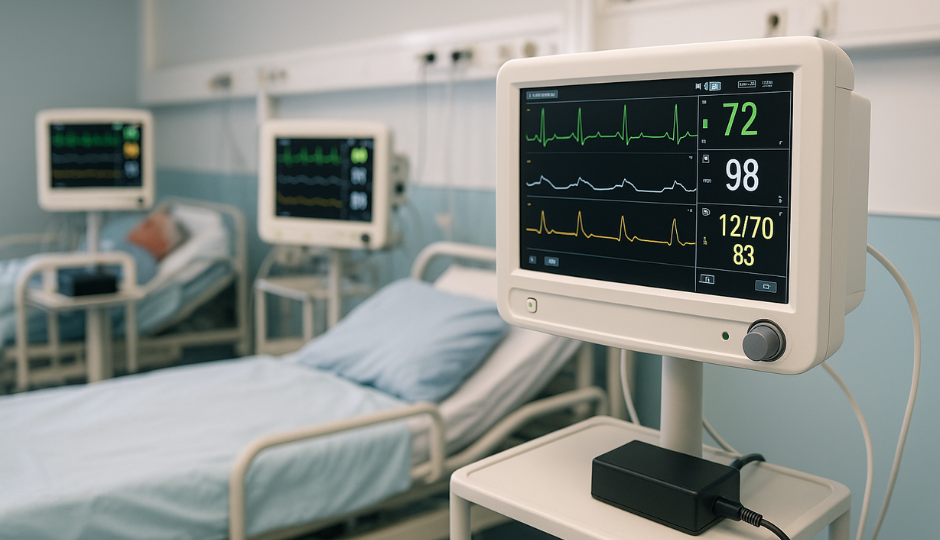The reliability of patient monitoring can mean the difference between timely care and a delayed response. But what if a commonly overlooked component—like a power adapter—is the root cause of failure?
No, standard power adapters should not be used for patient monitors. Patient monitoring devices require medical-grade adapters that meet strict safety, reliability, and hygiene standards to ensure continuous and safe operation in clinical settings.
When it comes to powering medical devices, such as patient monitors, the stakes are high. Patient monitors are used in the ICU, ER, and surgical wards, where they must operate continuously without interruption. Using a power adapter not designed for medical use can cause everything from inaccurate readings to sudden shutdowns. That’s not just inconvenient—it’s dangerous. In this article, I’ll break down the real differences between standard and medical-grade adapters, why this matters, and what to consider when sourcing for your project or product line.

What’s the Difference Between Standard and Medical-Grade Power Adapters?
When does an adapter stop being just an adapter?
Medical-grade adapters differ from standard ones in their safety certifications, leakage current limits, isolation design, and EMI performance. These features protect both the patient and the operator from electric shock and ensure that devices function without interference.
Let’s break this down. Standard power adapters—like those used for consumer electronics—follow general safety regulations (like UL or CE). But medical adapters comply with IEC 60601-1, a rigorous international safety standard for medical electrical equipment. One of its key requirements is low leakage current, usually no more than 100μA, to avoid shocking a patient who might be physically connected to electrodes, probes, or sensors.
Here’s a comparison table to illustrate the main differences:
| Feature | Standard Adapter | Medical-Grade Adapter |
|---|---|---|
| Safety Standard | UL/CE | IEC 60601-1 / EN60601-1 |
| Leakage Current | Up to 300μA or higher | <100μA |
| Isolation | Basic | Reinforced double insulation |
| EMI Suppression | General level | Medical EMI compliance (EN55011 Class B) |
| Usage Environment | Office, home | Clinics, hospitals, surgical settings |
| MTBF / Durability | Moderate | High reliability for 24/7 use |
As someone involved in designing devices for healthcare, I’ve seen how choosing the wrong power supply results in field failures, regulatory red flags, or worse—product recalls. For example, one team I worked with used an off-the-shelf adapter in early prototypes. It worked fine in testing, but failed EMC testing due to high leakage and emitted noise that affected ECG readings. That mistake cost three months in redesign.
Why Is Leakage Current So Dangerous in Patient Monitoring?
You might wonder, what’s the big deal with a little current?
Leakage current in non-medical adapters can pose serious risks to patients, especially those with invasive connections or in weakened conditions. Even micro-level currents can interfere with sensors or cause cardiac disturbance.
In ICU or surgical wards, patients are often connected to electrical devices through electrodes, catheters, or probes. A small current leaking from a poorly isolated adapter could travel through the patient’s body. This can disrupt readings from ECG or SpO2 sensors, or worse, cause electrical stimulation of the heart.
Let me illustrate with a real-world scenario. We had a client designing a compact vital sign monitor for neonatal use. They tested with a regular laptop-style power adapter for speed. However, during compliance testing, the system failed due to high leakage current. The solution was to switch to a certified 12V/3A IEC 60601-1 adapter. That single change not only resolved the problem, it also made the product safe for direct patient contact, which later became a marketing edge.
How Do Medical-Grade Adapters Help With EMI and Device Accuracy?
In sensitive environments, even a little noise can be a big problem.
Medical-grade adapters are engineered with advanced EMI shielding to prevent interference with other medical devices. This ensures consistent readings from patient monitors and protects nearby systems from disruption.
In hospitals, dozens of electronic devices run side by side—IV pumps, ventilators, monitors, and wireless devices. Electromagnetic interference (EMI) from one poorly shielded adapter can throw off an ECG trace, block Wi-Fi signals, or even trigger alarms on other machines.
To reduce this risk, medical-grade adapters comply with EN55011 Class B—a stricter EMI regulation than what is required for industrial or consumer use. They also include extra filtering and shielding.
I remember one incident where an ICU monitor started showing erratic pulse readings. After investigation, the root cause was a non-compliant adapter used on a nearby portable monitor, radiating noise through the shared power strip. Once replaced with a certified model, the problem vanished.
How Do Power Requirements Vary by Monitoring Scenario?
Is one power adapter good enough for all patient monitors?
No. Different hospital environments require different adapter features based on power demand, portability, and exposure to patients.
Here’s a quick breakdown of common medical scenarios and their specific power needs:
| Application Environment | Primary Concern | Recommended Adapter Features |
|---|---|---|
| ICU Monitoring | 24/7 uptime | High MTBF, medical-grade isolation, low EMI |
| Surgical Operating Room | Patient contact + precision | <100μA leakage, EMC Class B, ultra-low ripple noise |
| Emergency Transport Units | Mobile power source | Wide AC input, shock resistance, compact size |
| General Ward Monitoring | Basic vitals | Cost-effective, still compliant with medical safety norms |
For example, portable monitors used in ambulances need adapters with wide voltage input and good physical durability. In contrast, operating room monitors demand the strictest electrical protection because of patient contact and precise data accuracy needs.
These usage-based differences are why one-size-fits-all power supplies often fall short in real clinical use.

What Risks Do Buyers Face When Choosing the Wrong Adapter for Monitors?
It’s not just an engineering issue—bad adapter choices affect business outcomes.
Choosing the wrong adapter can lead to compliance failure, product returns, or even patient harm—each of which causes financial and reputational damage.
I’ve seen firsthand how poor adapter sourcing can create a cascade of problems. In one case, a buyer sourced standard power bricks for a new bedside monitor project to cut costs. The adapters looked fine but lacked IEC certification. As a result, the final product couldn’t pass CE testing, delaying market launch by three months. Worse, two hospital clients returned trial units due to EMI-related alarm errors.
Here are the common risks buyers face:
- Certification Risk: Uncertified adapters block CE, CB, and FDA approval
- After-Sales Risk: Higher return rate, more repairs due to unstable power
- Legal Risk: Potential liability if patient harm is linked to a power malfunction
- Reputation Risk: End-users lose trust in equipment that randomly shuts off
Smart procurement teams now prioritize power adapters as part of their quality-critical components, not just commodities.

What Technical Specs Matter Most When Selecting a Power Adapter?
Looking at just voltage and current isn’t enough.
To avoid failure or rejection, product teams must match electrical, mechanical, and regulatory specs precisely to the medical device’s needs.
Here’s a quick guide that I often share with customers during the adapter selection process:
| Specification | Recommendation for Patient Monitors | Pickinga common voltage without tolerance checks |
|---|---|---|
| Output Voltage | 12V / 15V / 24V (as per device spec) | Picking a common voltage without tolerance checks |
| Output Current | 2A–4A for typical bedside units | Underestimating peak current draw |
| Power Rating | 30W–65W for most monitors | Ignoring total load with accessories connected |
| Connector Type | Locking barrel / medical jack | Loose connections that cause resets |
| Leakage Current | <100μA (MOPP/MOOP compliant) | Exceeding limit, risking patient safety |
| Certifications | IEC 60601-1 / EN60601-1 / CE / UL / CB | Using only “general CE” and not full med-grade |
A proper supplier will help you walk through these details and provide all relevant documentation, including test reports and compliance files.
Conclusion
Standard power adapters may work for ordinary devices, but when it comes to patient monitors, only certified medical-grade adapters provide the safety, performance, and reliability these critical systems demand.




